

How to Use Inside Out in Your Classroom
Ideas for Boosting Mental Health at Every Grade Level
Teaching middle schoolers ( or anyone, really ) about the complexities of mental and emotional health is no easy task. Introducing emotions, learning how to identify and express feelings, and understanding how to cope with life is daunting. And the risk of inadequately teaching about these concepts is scary. But the danger of not even attempting to teach mental and emotional health is much more detrimental. So what's a middle school teacher to do?
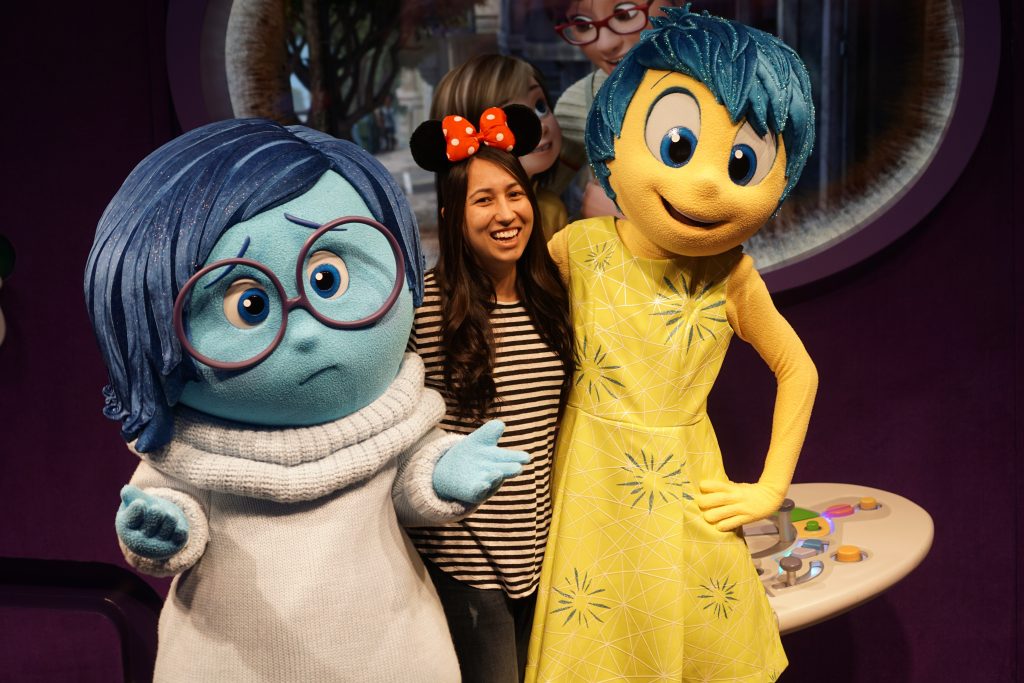
(Definitely worth the looooong Disney line)
Thankfully, we are now living in a post- Inside Out . And the Disney Pixar geniuses created a movie that breaks down barriers of vulnerability and creates a safe space to learn about the intricacies of mental and emotional health. The story of Riley's emotions and her journey to cope with major life changes is timeless, allowing viewers of all ages to powerfully connected with the themes of this film. It is a must-watch for every student (and teacher).
Using Inside Out to Teach Emotional & Mental Health
When I first watched Inside Out I was in the middle of creating a new health curriculum. As soon as I watched Riley's story unfold, I knew it would be the foundation of my emotional and mental health unit. Here's a quick refresher on what mental and emotional health is...
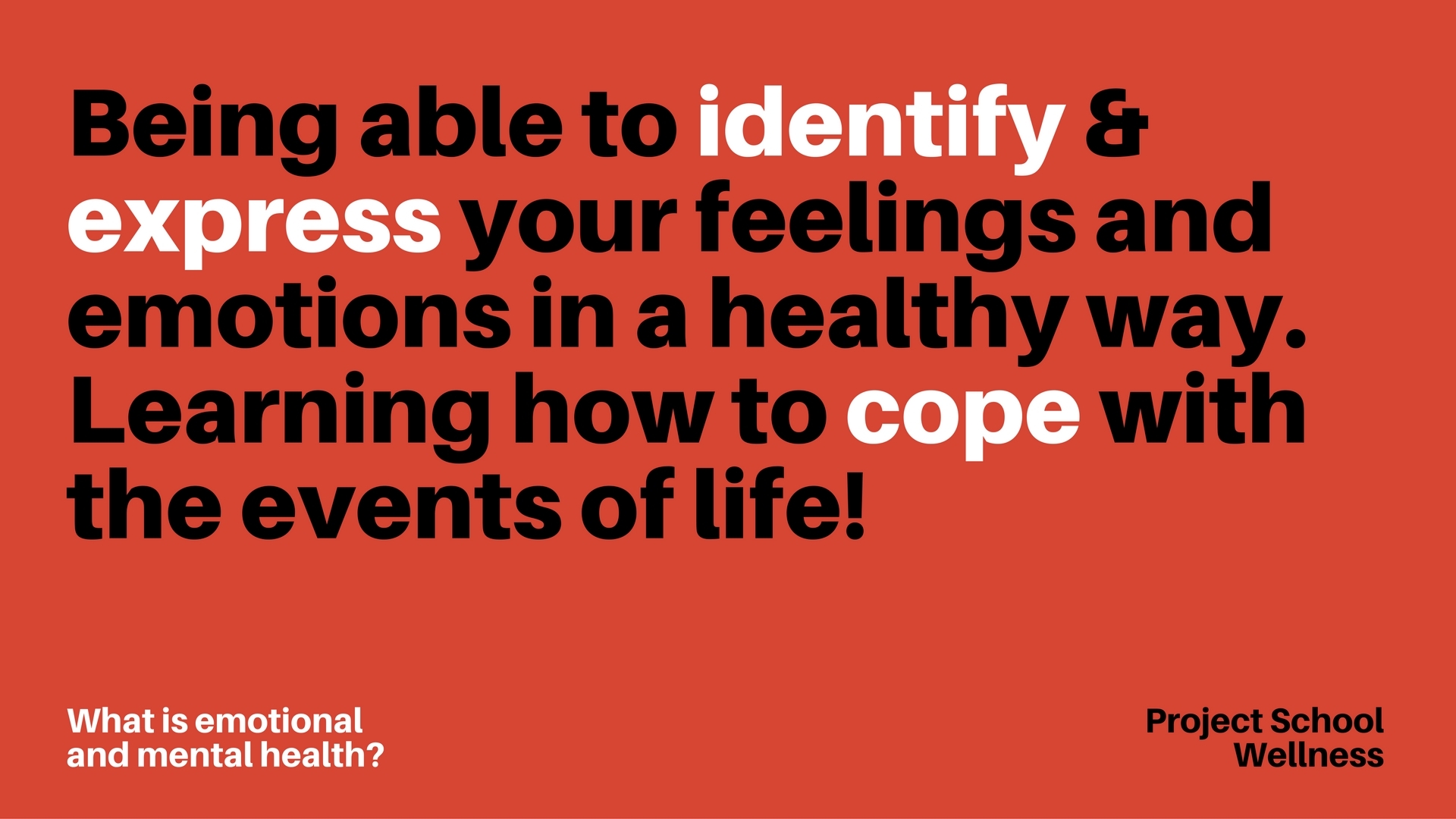
Due to health's interconnected and multidimensional nature , mental and emotional health plays a key role in empowering individuals to thrive. The ability to identify and express feelings and emotions and having the skills to cope with life is vital to well-being . Without these skills, we creep through life merely surviving.
To help that sink in, let's pause for a moment and think about everything connected to these skills: relationships of all types, school success, work success, physical health , and everything else in between. I am not exaggerating when I say it is if of the utmost necessity to teach students about mental and emotional health.
Okay, let me get off my soapbox. It's time to talk about how you can actually use Inside Out in your classroom.
Inside Out as a Teaching Tool
I'm not kidding when I say Inside Out is a must-watch. As I mentioned early, this movie breaks down barriers and allows students to look at the deepest and darkest aspects of their well-being. It creates a space for students to understand the complexities of human emotion and feelings. It also gives students language and insight to better express what they are feeling and working through in both the lowest and highest moments of life.
Depending on your students' age and life stories, the Inside Out experience is going to vary. There's no shortage of themes and topics presented throughout the movie. So to make it a little less daunting, I thought I'd share the topics that spoke most to my students and their situations....

Check out this Bundle
Using Inside Out in Elementary Health
For the lower grades, I think it is valuable to use Inside Out as a tool for teaching the fundamentals of emotional and mental health. For example...
- What are our different emotions?
- What is the purpose of each emotion?
- How do we express emotions we are feeling?
- How can we recognize the emotion someone else is feeling? (body language, actions, words)
Using Inside Out in Middle School Health
Along with the lower elementary grade teaching points, Inside Out can be used to teach students about...
- Developing healthy coping strategies
- Understanding how core memories shape our personality
- Discussing how and why our personalities evolve and change as we grow up
- Building empathy for others - as we have a chance to look into Riley's brain we see that there are powerful reasons why we make the choices we make
Using Inside Out to Teach Health in High School
Building upon what has been taught in the previous grades, as students get older Inside Out provides an opportunity to teach kids about...
- Mental health and how your mental health impacts each of the other components of your well-being
- Understand how emotions guide us through life
- Connect the value of possessing the language to express emotions as it relates to all areas of life (think: job success, relationship success, academic success)
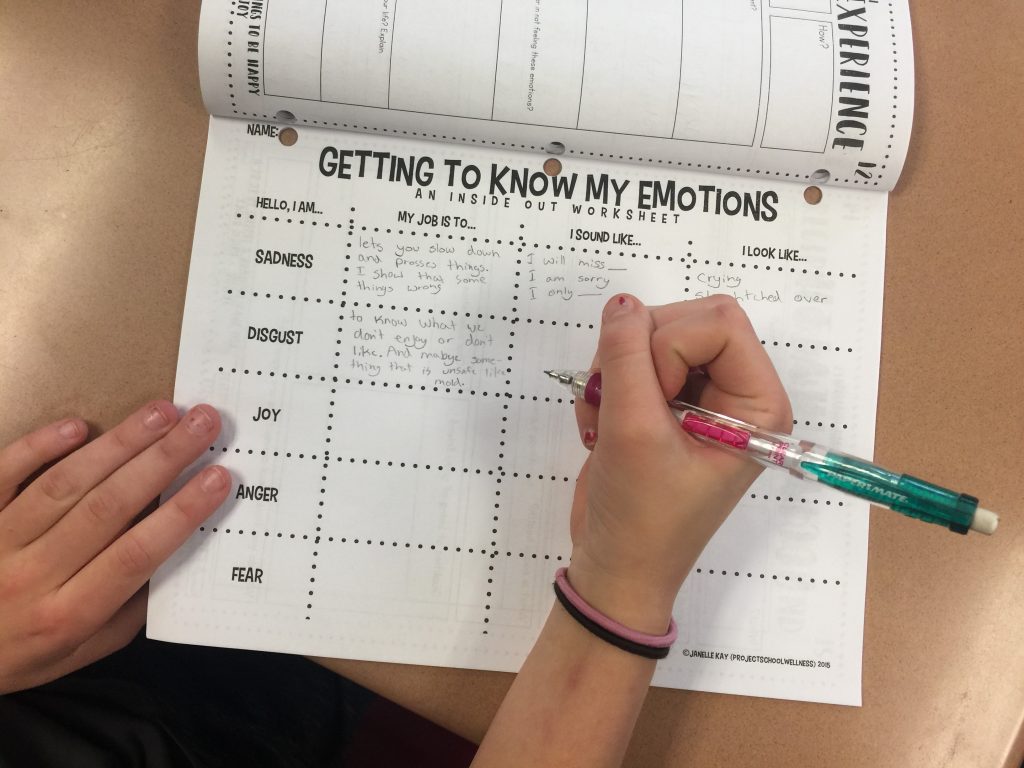
6th Grade after-movie worksheet
How I Use Inside Out to Teach Health
So what exactly does this look like in the classroom??? Well, I just wrapped up my second round of teaching Inside Out , so let's take a look at what I did. I began by choosing one specific focus for each grade level. There is so much going on in the movie and it is way too easy to overwhelm yourself and your students. Fight the temptation and just choose one topic.
Here's my topic choices - each based on of one of my Inside Out inspired worksheets
- 6th Grade - How to identify emotions using body language, action, and words
- 7th Grade - How to express emotions in a healthy and productive manner
- 8th Grade - Understanding the connection between mental and emotional well-being and total well-being
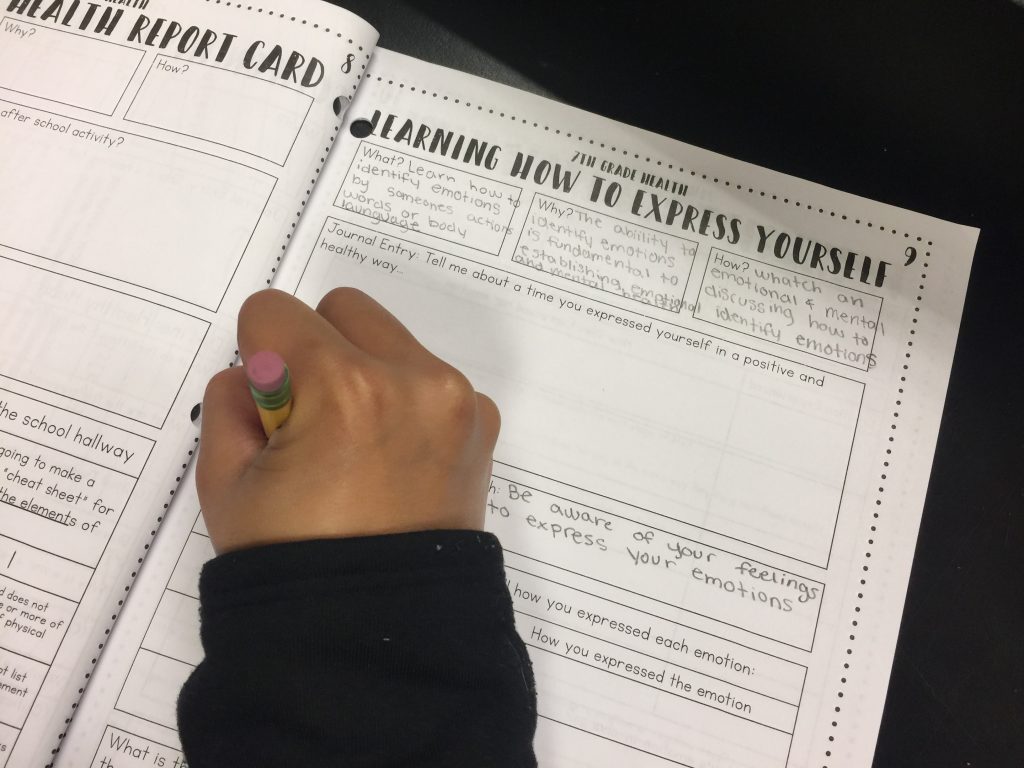
7th Grader pre-movie activity
And here's a look at the 4ish hour lesson progression...
- Lesson 1: Introduce the topic of mental and emotional health and prep students for viewing Inside Out
- Lesson 2: Movie time! As students watch the movie, they will take notes specifically connected to the class focus
- Lesson 3: After the movie's over, it's time for a class discussion and an Inside Out worksheet , again connected to their topic
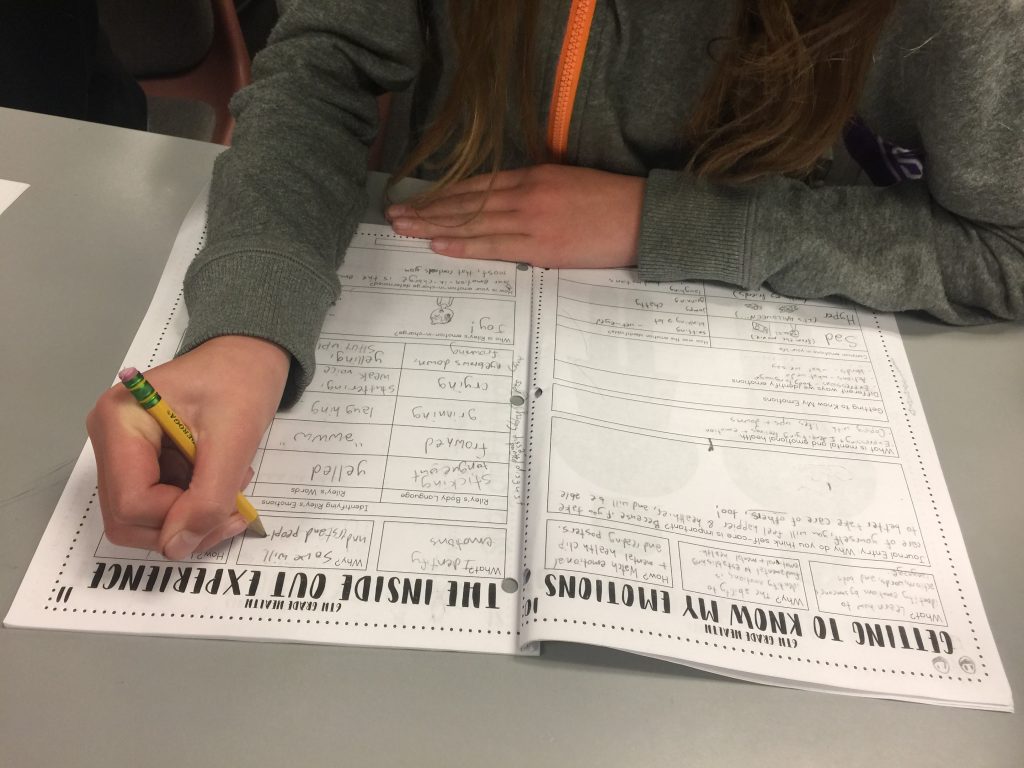
Here's a look at the 6th Graders pre and during movie activities
I really enjoyed this progression and method of using Inside Out - it was age-appropriate, challenging, and entertaining. Of course, using Inside Out will vary from teacher to teacher, which is the beauty of it. The possibilities are endless!
Buy our mega Inside & Out of Mental Health Bundle.
P.S. If you like this post, check out this post on Wonder by R.J. Palacio
Free Intro to Health Unit Plans
We've got you covered! Get instant access to five free health lesson plans for in-person or digital instruction.
Hello. I'm Janelle!
A middle school health teacher turned curriculum developer (and #WAHM). I'm on a mission to share the easiest-to-teach, most impactful health lesson plans on the Internet. Because your time and energy is better spent on teaching and connecting, not on planning and prep.

23 Comments
Good evening! Thank you SO MUCH for your passion and all your hard work in creating this! I’ve been wanting to use this movie for lessons ever since it came out, but I just haven’t had the time to do so yet. I have a quick question, though – I purchased the bundle (I think it was $12 or something), and it came with a ton of great worksheets and guides, but I noticed some pictures on this page that are not included. Are those somewhere else? Do I need to purchase something different for the pre-movie and during movie activities? Thanks again! 🙂
Thanks for posting and sending me an email! I can’t wait to see how it goes in your classroom!
I also purchased the bundle, but did not see the pictures from this post. How do I get the pre-movie and during movie activities?
Thanks for the note. I’m in the process adding the pre-movie & during movie activities to the existing products. If you send me an email at [email protected] , we can figure out a way to get them to you!
I’m trying to access the freebee sampler and it is telling me that I need a password. How might I get a password? Thank you 🙂
Thanks for the interest in the discussion sampler. If you sign up for our newsletter, you’ll receive the access code! Click here to get access.
Please let me know if you have any other questions!
I purchased the bundle. Received no confirmation email. Will it be mailed to my house or am I suppose to get online?
I’m sorry for the delayed email delivery. It should arrive in your inbox directly after purchasing. I just resent your receipt. Please email me if you still cannot access your purchase – – [email protected] .
Thank you and have a wonderful day,
Hi Janelle,
I purchased your bundle and love the material. I can’t wait to start teaching it to my 6th graders. I found the video on youtube, but I can’t find the link to the teaching powerpoint. Would you be able to help me with this? It would be really helpful if I had it.
Thank you for doing what you do!
Hey Catherine,
I’m so sorry that I’m just seeing this message! The link for the teaching PowerPoint should be at the top of the teaching direction page. If you are still having trouble finding it please email me at [email protected] .
Again, I’m really sorry for the delay in responding.
Have a great day,
Hi Janelle, I’m experiencing the same problem, and I’m not able to access the PowerPoint or the video links in the document. How can I access these?
Hey Stephanie,
I’m sorry for the inconvenience! Would you mind sending me an email at [email protected] ? And I will help fix this issue.
I’ve done a project several times using Inside Out where I have my students draw their own emotion characters and Islands of Personality. I’ve done this with middle school, high school, and adults, and it’s always a really great discussion starter. This is one of my favorite movies ever, and I’m psyched about looking more closely and incorporating some of your ideas into future lessons using the movie.
Hey Jessica,
That is so awesome to hear! Every time I watch it I’m more amazed at the genius of the storytelling!
Just out of curiosity…Disney is NOTORIOUS for going after teachers for using their videos as copyright infringement. They have closed their Education Products site, and I cannot see where Inside Out ever had a classroom edition. Can anyone tell me how they are addressing the copyright infringement issue of using a non-classroom edition DVD in their class? Thanks!
I’m sorry that I don’t have a better answer but I’d suggest asking someone at your district office for guidance. Each school district seems to have a different protocol for these types of situations.
Again, sorry I couldn’t help more!
Hi Janelle, My name is Kerrie and I am currently volunteering (long term) in a Juvenile Detention Centre in Thailand. There are about 900 young people in the facility. I was wondering if I could email you privately regarding the use of your curriculum? Thanks, Kerrie
Hey Kerrie,
Yes, of course. Email me at [email protected] .
Thank you and I look forward to connecting.
Thanks for sharing! It gave me some ideas for teaching a group of primary 4 students in HK remotely! We’re on the topic of “Living Healthily” and I do want students to know mental health is so important too!
Thank you for connecting! I’m so glad it was helpful.
Hello, just purchased the bundle and I’m going through it, Can’t wait to use it. In lesson #1 teaching powerpoint, , it mentions filling out “the emotional and mental health wedge on Step 2 of the Wellness Wheel”. Have I missed where this is? Is this not included in the bundle?
Hey Gillian,
If you send me an email at [email protected] , I’ll send over the resource.
[…] Emotions, goal setting, empathy, relationship building, and decision making. Yes, please! I don’t think any teachers will debate the importance of social-emotional learning and these vital life skills. […]
Leave a Comment Cancel Reply
Inside Out Movie | SEL Worksheets, Task Cards, Matching Game, Craft, & more

- Google Apps™
What educators are saying
Also included in.
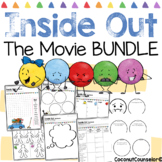
Description
This Social Emotional Learning movie companion to Inside Out goes over topics in joy, sadness, anger, disgust, and fear including identifying emotional triggers, emotions body mapping, gratitude, imaginative play, and more. Digital on Google Slides and PDF Color and Black & White . Multiple versions with blank, primary lines, and regular lines. NOTE - Some of the digital activities may be a bit too complex for some primary learners.
- 16 Task Cards (also digital)
- Matching Card Game with 12 Matches
- Craft - Create Your Own Imaginary Friend (also modified for digital)
- Identifying Emotions Triggers Worksheets (also digital)
- Emotions Body Mapping Worksheets (also digital)
- Core Memories Worksheet (also digital)
- Personality Islands Worksheets (also digital)
- Working the Control Board - Stop, Think, Act Worksheets (also digital)
- Direct Your Own Dream Worksheets (also digital)
- Defining the Character of Riley Worksheets (also digital)
- Acrostic Poem Worksheets (also digital)
- A Thank You Letter to Your Control Board Worksheets (also digital)
- Word Search (also digital)
- Crossword Puzzle (also digital)
- Coloring Page
Questions & Answers
Coconut counselor.
- We're hiring
- Help & FAQ
- Privacy policy
- Student privacy
- Terms of service
- Tell us what you think
“Inside Out”: Riley’s Psychological Analysis Research Paper
Introduction.
The academic study of cartoon works is essential to detail psychological analysis because it allows to summarize and assess the applicability of theoretical concepts in practical implementation. The core of this statement is the recognition that contemporary cartoons rarely serve a pure entertainment function but instead aim to educate viewers about specific patterns and qualities. This genre of cinematography is mainly aimed at the children’s audience, which means that the task of the screenwriters is to create such material that would be able to tell the severe emotional problems of the real world in a simple and understandable form for the young viewer. This works even when the authors embody the most fantasy reality on the screen and give the characters incredible superpowers.
Particular attention in the genre of cartoons deserves the legendary Disney company. Its unique feature is a long history of the brand, which has become the center of attention for more than a dozen generations. Consequently, not only modern children but also their parents and grandparents grew up in the works of this animation company. This reason underlies the in-depth development of the published animated works, as the company’s management is aware that not only children will be present at the film screenings. The characters in all of the company’s films have a high degree of personal development and scripted motivation, and therefore it is appropriate to study whole concepts of a psychological theory of personal development on their example.
Among the majority of modern Disney cartoons, each of which deserves to be in the center of this analysis, the most interesting is the material of 2015 by the American animator Pete Docter, namely Inside Out. The cartoon is an excellent demonstration of the age dynamics of a protagonist named Riley going through severe emotional crises and the severity of her relationship with her parents. Through the example of Inside Out, one can trace the depth of psychological study of theories from Freudian concepts of childhood to Jungian archetypes of the Shadow. A detailed, critical analysis of this film from the perspective of a psychotherapy student is the core of this research paper.
A Brief Summary of the Film
The narrative of this animated work centers on the life and growing up of an eleven-year-old girl named Riley, the only child in a whole family. Due to work circumstances, the family has to move from their native place of residence, Minnesota, to a poor neighborhood of San Francisco, and as a result, the girl’s habitual way of life changes dramatically. Riley is forced to go to a new school, make acquaintances and, most importantly, give up her favorite hobby, hockey, because, in this region, the sport is not available to children. As a result, the girl is going through a complex change crisis, for which she was not yet ready. The situation is complicated by the lack of deep family ties shown: certainly, mother and father spend time together with their daughter, but there seems to be no real understanding between them.
The title of the film Inside Out was not given to work because of its romantic and intriguing sound or its deep subtext. On the contrary, the film uses the concept of the five fundamental emotions that determine each individual’s behavior. The film repeatedly shows that every living being, whether human or animal, is guided by their emotions in all decisions. These five include Joy, Sadness, Fear, Anger, and Disgust, each of which appears as multicolored humanized beings living in the character’s mind. Moreover, each of the emotions seems equivalent, and there is a partnership between them in general. This refers to the status of the active emotion, the fairness of duty over Riley’s dream, or the contemplative nature of crucial decision-making.
Another intriguing feature of the cartoon is the concept of spherical capsules that hold all of the individual’s memories. The inner world of an individual’s consciousness is much deeper than the brain center with its five key emotions and is represented by billions of memories, locations, and images, creating the individual’s worldview. In addition, all the characters from a person’s dreams live in this world and the workers who remove old memories and control the effectiveness of memory. The primary emotions can load balls of memories into the receiver so that Riley “recalls” specific events at a given moment: this is a critical skill that will decide an essential role in the girl’s behavior.
Family Portrait Analysis
As a typical younger generation member, Riley is an active, generally cheerful child, successfully balancing school, relationships with friends, sports, and spending time together with her parents. The film showed the family spending every evening dinner together, discussing current problems and sharing feelings. Such parenting methods are known to be an excellent implementation of the strategy of the harmonious development of the child’s personality (Camarero-Figuerola, 2020). As mentioned, Riley is an eleven-year-old white girl, and her parents are probably no more than forty years old. There is every reason to believe that both parents are related to Riley since no statement to the contrary has been made.
It is interesting to note that Riley is the classic collective image of children at this age. Riley is just entering a phase of adolescence in which critical changes in not only her appearance but also her conscious perception of reality are noticeable (Morin, 2019). In terms of physical growth, the high school student has the shapely physique of a young girl (Balaban, 2018). In terms of cognitive development, Riley also demonstrates necessary transformations for an eleven-year-old girl: doubt in authority figures (parents), resistance to physical and spiritual intimacy with them, and attempts to run away from home (Ropes, 2020). All of this together makes it clear that Riley’s image is not random: the authors deliberately tried to create an archetype that would have critical characteristics for this age group.
In the context of a family portrait, this family can be described as entirely stereotypical. This includes a hockey-loving father passionate about his career, a stay-at-home mother willing to find compromise in any scandal, and a curious daughter who has the classic selfish views of the only child in the family (Bai et al., 2019). The religious views of the family members were not discussed during the film, but it can be assumed that they are either American Christians or nonbelievers. In contrast, the socioeconomic status of the family was well discussed in Inside Out. As typical middle-class people, the Riley family cannot afford to buy an expensive home in a prosperous area of western California. Instead, they have to buy an empty house with no furniture in a dilapidated neighborhood in San Francisco.
Finally, to complete the portentous analysis of the narrative family, it is appropriate to consider the positions of the gender and sexual identities of the protagonists. The work did not explicitly state the presence of any LGBTQ+ community members or gender identities other than the innate gender characteristics of the individuals. In addition, in the depths of Riley’s subconscious, a young boy, whose archetype is her love reference, was spotted. Subsequently, Riley will meet a similar boy in real life, which directly alludes to the possibility of a romantic relationship between children. As a consequence, it is possible to state with complete confidence the heterosexual orientation of the girl.

The Theory of Psychoanalytic Development
The Freudian view of psychoanalysis may cause many doubts and discussions in the academic community, which, however, do not invalidate the fact that it is possible to apply the researcher’s concepts to actual cases. In fact, Sigmund Freud is one of the most recognizable figures of psychological personality theory, whose ideas are often disseminated even to an untrained audience. Freud’s theory of psychoanalysis is built on several pillars, which are revealed by a detailed examination of the film Inside Out.
The first of these factors is the idea of determinism, which postulates the predetermination of the manifestation of the psyche. The entire movie seems to be built on this concept, as a built-in mechanism directly sets all emotional patterns: the little cognitive beings that control Riley’s emotions and memory. As a result, all the actions manifested by the individual have a causal origin, which is what the authors laid down in the creation of this animated work. Moreover, it has been shown that each individual’s key emotions are unique and have similar features of appearance and behavior. Consequently, it is appropriate to assume that these creatures are born together with a person and exist together with them throughout their life. In turn, this means complete continuity of the adult individual’s worldview from childhood.
Another intriguing illustration of Freudian psychoanalysis concerning Riley is the concept of sublimation. As it is known, in psychology, the term refers to an individual’s defense mechanism aimed at redirecting excess energy into an alternative channel to achieve positive outcomes (Even-Tzur & Hadar, 2019). This method allows one to relieve stress and reach heights in creativity, sports, or hobbies. Riley demonstrated an example of sublimation while playing on the hockey field when control of her life was handed over to Anger. The aggressive girl, overwhelmed with destructive feelings, decided to channel that energy into sports, which is an excellent example of sublimation.
Cognitive Development
There are quite a few well-known theories that study the evolutionary development of personality in parallel with the maturation of the individual. There is no doubt that one of the best known is Piaget’s theory, which categorizes dynamic growth as a sequence of alternating phases associated with age. According to Piaget’s theory, Riley is in an intermediate state between a period of concrete operations and a phase of formal operations (Bormanaki & Khoshhal, 2017). Theoretically, this means that the girl already has a formalized logical thinking system but still operates with little abstract thinking. In addition, according to Piaget, Riley can make her assumptions and hypotheses. Consequently, perceived knowledge builds up not in the form of individual micro-themes or lists but as a coherent system.
Assuming that the key five emotions are not individual personalities within the individual but rather a comprehensive resource structured by responsibilities, one can notice a strong correspondence between Riley’s personality and Piaget’s theory. In the first place, Riley has concluded on her own (or, more accurately, through emotion) that her current life does not bring her joy, and therefore she needs to return to Minnesota. Riley correlates the deterioration of her emotional state with the move and her new surroundings, and therefore, as a result, tries to escape from home. It was a constructed hypothesis that the girl would be able to get everything back if she moved back: thus, if the story were to allow her to return to her hometown, she would be able to test this hypothesis for validity.
Application of Skinner’s Theory
Another interesting theory relevant to this cartoon is Skinner’s theory of operant learning. The core of this theory is the idea that human or animal behavior can be conditioned by the use of stimuli that the subject may or may not consider satisfactory for a particular case (Devaki, 2021). Specifically, the patterns of an individual’s behavior are governed by positive reinforcers, prizes, memories, or rewards. It is a memory that is the key factor within this film, as in Inside Out, Riley repeatedly turns to deep capsules to calm himself in the face of stress. On the other hand, the Emotions themselves determine the girl’s behavior: in moments of critical need, key emotions determine which memories or patterns to turn to guide Riley.
Existential Development
Finally, the most unobvious element of Riley’s story is the discovery of the Jungian Shadow in the protagonist’s life. It is worth recalling that Carl Jung constructed the nature of an individual’s personality according to a triangular system, the basis of which was psychic energy. The individual’s consciousness forms the apex of the triangle, and between the two boundaries is the unconscious, including the archetype of the Shadow. The Shadow, according to Jung, is a particular component of the unconscious system, which is an autonomous unit consisting of personal and collective attitudes (Freysson, 2020). Failure to accept the Shadow leads to personality incoherence and thus to the most serious internal conflicts.
In relation to Riley, such a Shadow can be referred to as the emotion of Sadness, which is traditionally perceived by society as a negative, demanding side. Sadness in the film is not a self-sufficient unit and requires the support of Joy, the situational leader of the whole five. Thus, Riley cannot accept Sadness and instead tries to shut down the emotions of Joy even where they are inappropriate. In turn, this strategy leads to a lack of harmony between emotions, and as a result, Riley’s deep stress. It is likely that if the girl had been initially normal about her Sadness and Sadness, she would have had no problem expressing her emotions.
Christian Context
An essential part of psychological counseling is the professional ethics that govern the nature of the relationship between the parties. If biblical teachings are used as the source of such ethics, it is appropriate to form some vision of Riley’s ultimate client management strategy. In an initial analysis, systemic counseling, and making work proposals, it is critical to consider the client’s religious background and not create solutions contrary to the foundations of Christianity. In addition, Riley should not have been suggested to study on Sundays if it interfered with church attendance. Simultaneously, the Bible suggests personal development by demonstrating love for God, so finding integrations between academic personality psychodynamics and Christian precepts would be an intelligent solution.
In closing, it should be noted that animated films are often profound reflections of existing theories of personality psychology. In the film Inside Out, Riley’s review of the protagonist successfully identifies the motivators and driving forces driving the girl’s life and behavior. It has been shown that Riley can be seen as a collective image of critical physiological and cognitive transformations occurring to an individual at the age of eleven. In addition, concerning Riley, it was appropriate to consider the academic views of Freud, Jung, Skinner, and Piaget as reflected in the character’s behavior.
Bai, B. Y., Tan, X. Y., Zhang, N., & Yang, Y. (2019). Social dominance orientation and selfish behaviors in Chinese adolescents: The mediating role of psychological entitlement. Child Indicators Research, 1-11.
Balaban, V. (2018). The relationship between objectively measured physical activity and fundamental motor skills in 8 to 11 years old children from the Czech Republic. Montenegrin Journal of Sports Science and Medicine, 7 (2), 11-16.
Bormanaki, H. B., & Khoshhal, Y. (2017). The role of equilibration in Piaget’s theory of cognitive development and its implication for receptive skills: A theoretical study. Journal of Language Teaching & Research, 8 (5), 1-13.
Camarero-Figuerola, M., Dueñas, J. M., & Renta-Davids, A. I. (2020). The relationship between family involvement and academic variables: A systematic review. Research in Social Sciences and Technology, 5 (2), 57-71.
Devaki, V. (2021). Influence of Behaviourist and cognitivist theories in adult language acquisition. Elsya : Journal of English Language Studies, 3 (1), 38-44.
Even-Tzur, E., & Hadar, U. (2019). Socially accepted violence by “agents of law”: Sublimation of aggression as a model. Aggression and Violent Behavior, 47 , 21-28.
Freysson, E. (2020). The hidden side of the soul: how the shadow archetype relates to human evil [PDF document]. Web.
Morin, A. (2019). 11-year-old child development milestones . Very Well Family. Web.
Ropes, K. (2020). The intersectional effects of race and gender on time to. Lead Exposure, Concentrated Disadvantage, and Violent Crime Rates Tara E. Martin and Scott E. Wolfe 25 Puberty and Girls’ Delinquency: A Test of Competing Models Explaining the Relationship between Pubertal Development and Delinquent Behavior, 37 (1), 132-160.
- Chicago (A-D)
- Chicago (N-B)
IvyPanda. (2022, June 25). “Inside Out”: Riley's Psychological Analysis. https://ivypanda.com/essays/inside-out-rileys-psychological-analysis/
"“Inside Out”: Riley's Psychological Analysis." IvyPanda , 25 June 2022, ivypanda.com/essays/inside-out-rileys-psychological-analysis/.
IvyPanda . (2022) '“Inside Out”: Riley's Psychological Analysis'. 25 June.
IvyPanda . 2022. "“Inside Out”: Riley's Psychological Analysis." June 25, 2022. https://ivypanda.com/essays/inside-out-rileys-psychological-analysis/.
1. IvyPanda . "“Inside Out”: Riley's Psychological Analysis." June 25, 2022. https://ivypanda.com/essays/inside-out-rileys-psychological-analysis/.
Bibliography
IvyPanda . "“Inside Out”: Riley's Psychological Analysis." June 25, 2022. https://ivypanda.com/essays/inside-out-rileys-psychological-analysis/.
- Sociological Concepts in the "Inside Out" Film
- Group Disease: Riley’s Case
- Sorry to Bother You by B. Riley: A Film Review
- Digital Business Management for Riley a digital online game and entertainment company.
- "Movement in Squares" Abstract Painting by Riley
- Motivation Theories and Definition
- Janet Riley iHuman Case: Neuroimaging
- The Analysis of the Movie "Inside Out" by Pixar
- Gangsta Rap Music as Social Culture in the Journal of Youth Studies by Alexander Riley
- “Inside Out” by Docter
- Disability: Coping and Adjustment
- Mental Conditioning: Overcoming Challenges
- Bystander Effect: The Stanford Experiment
- Changes in Life and Psychological Stress Assessment
- Stuttering Management: Psychological Therapy Effectiveness

Inside Out: Emotional Truths by Way of Pixar
"inside out" proves true to cognitive, developmental, and clinical psychology..
Posted June 24, 2015 | Reviewed by Kaja Perina
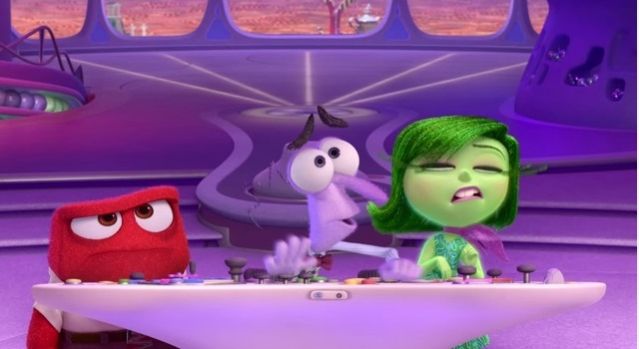
Dr. Janina Scarlet reviewed the film Inside Out and wanted to share her thoughts with Psychology Today readers. by Janina Scarlet
Inside Out is a movie I’d been waiting for a year to see and, once again, Pixar did not disappoint. This is a movie I’m going to be assigning to many of my patients and doctoral students as a way to demonstrate important psychological principles.
Warning: some spoilers of the movie ahead.
The movie is about an 11-year-old girl, Riley, originally from Minnesota, who moves to San Francisco with her parents. The leading characters of the movie, however, aren’t Riley and her family, but Riley’s primary emotions: Happiness (Joy), Sadness, Fear , Anger , and Disgust. These emotions demonstrate what it might be like in the mind of an 11-year-old girl who struggles with having to move to a different city, away from her friends, away from her hockey league, and has a hard time pretending to be happy for her parents.
What’s really powerful about this film is how accurate it is to cognitive, developmental, and clinical psychology. The 5 emotions used in this film are in fact 5 of the 6 scientifically validated universal emotions (the 6th one being surprise). Psychologist and scientist, Paul Ekman, is most known for his work with universal emotions as he traveled around the world and found that these were present in every culture and presented in the same way through the same facial expressions around the world. Ekman’s work has been used for psychology research, as well as for the US government, and even inspired the popular television series, ‘Lie to Me’.
Other concepts displayed in this movie included the conversion of short to long-term memory . When a memory is seen as salient or relevant enough to us, or when it has been repeated enough times, the brain messengers, dopamine and glutamate, ensure the long-term encoding of that memory. Think of these messengers as computer coders or awesome IT support team – they write the code to ensure that our brain computer is up to date with the new information. Other concepts briefly covered in the movie include psychological changes of reaching/approaching puberty , psychological stressors, family psychology, inductive and deductive reasoning (thinking like Sherlock Holmes by using logic, reasoning, and observation to reach a conclusion), and many others.
Of all 5 of Riley’s emotions, Joy seems to be the leader, she keeps the others in check but reminds the viewers that all of them have an important function. She states that Disgust keeps Riley safe from being poisoned, Fear keeps her safe from a catastrophe by imagining worst case scenarios, Anger protects her from others and also allows her to be a better hockey player, while Joy ensures that Riley is happy. However, Joy fails to see the importance of Sadness and tries to shoo Sadness away from anything Riley-related, forbidding this emotion in every way possible. She even draws a circle on the floor and makes Sadness stay inside it, forbidding her to leave or to touch any of Riley’s memories, so as not to taint them with sad memories.
As if Riley’s mind trying to keep Sadness at bay wasn’t enough, Riley’s parents put an additional pressure on her, especially when her mother asks her to “keep smiling” for her dad. Essentially, Riley’s mom, without meaning to do so, communicates to Riley that being sad about the move was not ok and that she needs to pretend to be happy to support her father through this.
Unfortunately, Joy’s good intentions backfire when Riley is unable to receive the support she so desperately needs to help her with adjusting to her new environment. In fact, Riley initially seems to be having symptoms of an Adjustment Disorder with Depressed Mood, where she has a hard time coping with her move, she withdraws from her parents and old friends, she misses school, and even tries to run away. By being unable to experience her sadness about all these changes and pretending that she was ok, Riley ends up being angry, anxious, and irritable, getting into a fight with her parents and her best friend, before shutting down altogether. In fact, it looks like Riley’s potential Adjustment Disorder might have turned into a full-blown Major Depressive Episode. (I’m saying, “might have” because in order to be diagnosed, the symptoms need to have lasted for 2 weeks or more, and we don’t know how long Riley’s symptoms actually lasted).
What messages does this movie send to its viewers?
Many, actually, but perhaps the most important one is this – our emotions are all important, every single one of them. They all serve an important function and we cannot selectively feel some but not others. It’s an “all-or-none” deal. If we numb sadness, we also numb joy. We need to openly experience all our emotions, and that includes sadness, as painful as it may be sometimes. Sadness allows for connection, when we see someone else feeling sad, we might feel sad too (this emotion is called empathy) and might want to alleviate their sadness (this is compassion). When we stay with this individual and share our emotions together, the resonating effect can produce a healing experience. That is exactly what we see when Sadness comforts Riley’s imaginary friend, Bing Bong, and also when Riley is able to share her sadness with her parents.
In fact, when we are sad, our body and facial expression cue the people around us that we need help – the tears running down our face, the pupil dilation, the non-threatening posture, all of this signals others that we could use some support. And at the same time, the people around us might then experience a bitter-sweet sensation of compassion, caused by an activation of the compassion centers of our brain (the insula and the anterior cingulate cortex, among other structures), and the warmth of the heart caused by a release of a special “cuddle” hormone , oxytocin (so called because it is released when we want to or are in the process of hugging someone, or similar actions).

The movie doesn’t stop there; it ends with a bang by reminding us that we can experience multiple (and even contradictory) emotions at the same time, such as happiness and sadness. The movie also shows that everyone experiences these emotions, as they are, in fact, universal. This demonstrates a psychological concept of common humanity, or the idea that other people are just like us, they might struggle with the same emotions, insecurities, heartbreaks, and neuroses as we do, further validating our internal experiences.
Overall, ‘Inside Out’ was amazing. I highly recommend it and would love to hear your opinions on it.
Dr. Janina Scarlet is a Licensed Clinical Psychologist, a scientist, and a full time geek. She uses Superhero Therapy to help patients with anxiety , depression , chronic pain , and PTSD at the Center for Stress and Anxiety Management and Sharp Memorial Hospital. Dr. Scarlet also teaches at Alliant International University, San Diego. Her book, Superhero Therapy, is expected to be released in July 2016 with Little, Brown Book Group.
Original post at Superhero Therapy: Psychology of "Inside Out." Shared at the author's request, with permission.

Travis Langley, Ph.D. , a professor at Henderson State University, is the author of Batman and Psychology: A Dark and Stormy Knight.
- Find a Therapist
- Find a Treatment Center
- Find a Psychiatrist
- Find a Support Group
- Find Teletherapy
- United States
- Brooklyn, NY
- Chicago, IL
- Houston, TX
- Los Angeles, CA
- New York, NY
- Portland, OR
- San Diego, CA
- San Francisco, CA
- Seattle, WA
- Washington, DC
- Asperger's
- Bipolar Disorder
- Chronic Pain
- Eating Disorders
- Passive Aggression
- Personality
- Goal Setting
- Positive Psychology
- Stopping Smoking
- Low Sexual Desire
- Relationships
- Child Development
- Therapy Center NEW
- Diagnosis Dictionary
- Types of Therapy

Understanding what emotional intelligence looks like and the steps needed to improve it could light a path to a more emotionally adept world.
- Coronavirus Disease 2019
- Affective Forecasting
- Neuroscience
Greater Good Science Center • Magazine • In Action • In Education
Education Articles & More
Four lessons from “inside out” to discuss with kids, the new pixar film has moved viewers young and old to take a look inside their own minds..
Since its release, Inside Out has been applauded by critics, adored by audiences, and has become the likely front-runner for the Academy Award for Best Animated Feature.
But perhaps its greatest achievement has been this: It has moved viewers young and old to take a look inside their own minds. As you likely know by now, much of the film takes place in the head of an 11-year-old girl named Riley, with five emotions—Joy, Sadness, Anger, Fear, and Disgust—embodied by characters who help Riley navigate her world. The film has some deep things to say about the nature of our emotions—which is no coincidence, as the GGSC’s founding faculty director, Dacher Keltner, served as a consultant on the film, helping to make sure that, despite some obvious creative liberties, the film’s fundamental messages about emotion are consistent with scientific research.
Those messages are smartly embedded within Inside Out ‘s inventive storytelling and mind-blowing animation; they enrich the film without weighing it down. But they are conveyed strongly enough to provide a foundation for discussion among kids and adults alike. Some of the most memorable scenes in the film double as teachable moments for the classroom or dinner table.

Though Inside Out has artfully opened the door to these conversations, it can still be hard to find the right way to move through them or respond to kids’ questions. So for parents and teachers who want to discuss Inside Out with children, here we have distilled four of its main insights into our emotional lives, along with some of the research that backs them up. And a warning, lest we rouse your Anger: There are a number of spoilers below.
1) Happiness is not just about joy
When the film begins, the emotion of Joy—personified by a manic pixie-type with the voice of Amy Poehler—helms the controls inside Riley’s mind; her overarching goal is to make sure that Riley is always happy. But by the end of the film, Joy—like Riley, and the audience—learns that there is much, much more to being happy than boundless positivity. In fact, in the film’s final chapter, when Joy cedes control to some of her fellow emotions, particularly Sadness, Riley seems to achieve a deeper form of happiness.

Honoring the Teacher's Heart: Well-Being Practices for School Change
Join a new Community of Practice for educators and school leaders
This reflects the way that a lot of leading emotion researchers see happiness. Sonja Lyubomirsky, author of the best-selling How of Happiness , defines happiness as “the experience of joy, contentment, or positive well-being, combined with a sense that one’s life is good, meaningful, and worthwhile.” (emphasis added) So while positive emotions such as joy are definitely part of the recipe for happiness, they are not the whole shebang.
In fact, a recent study found that people who experience “emodiversity,” or a rich array of both positive and negative emotions, have better mental health. The authors of this study suggest that feeling a variety of specific emotions may give a person more detailed information about a particular situation, thus resulting in better behavioral choices—and potentially greater happiness.
For example, in a pivotal moment in the film, Riley allows herself to feel sadness, in addition to fear and anger, about her idea of running away from home; as a result, she decides not to go through with her plan. This choice reunites Riley with her family, giving her a deeper sense of happiness and contentment in the comfort she gets from her parents, even though it’s mixed with sadness and fear.
In that light, Inside Out ’s creators, including director Pete Docter, made a smart choice to name Poehler’s character “Joy” instead of “Happiness.” Ultimately, joy is just one element of happiness, and happiness can be tinged with other emotions, even including sadness.
2) Don’t try to force happiness
One of us (Vicki) felt an old, familiar frustration when Riley’s mother tells her to be her parents’ “happy girl” while the family adjusts to a stressful cross-country move and her father goes through a difficult period at work. As a child, Vicki got similar messages and used to think something was wrong with her if she wasn’t happy all the time. And all the research and press about the importance of happiness in recent years can make this message that much more potent.
Thank goodness emotion researcher June Gruber and her colleagues started looking at the nuances of happiness and its pursuit . Their findings challenge the “happy-all-the-time” imperative that was probably imposed upon many of us.
For example, their research suggests that making happiness an explicit goal in life can actually make us miserable. Gruber’s colleague Iris Mauss has discovered that the more people strive for happiness, the greater the chance that they’ll set very high standards of happiness for themselves and feel disappointed—and less happy—when they’re not able to meet those standards all the time.
So it should come as no surprise that trying to force herself to be happy actually doesn’t help Riley deal with the stresses and transitions in her life. In fact, not only does that strategy fail to bring her happiness, it also seems to make her feel isolated and angry with her parents, which factors into her decision to run away from home.
What’s a more effective route to happiness for Riley (and the rest of us)? Recent research points to the importance of “prioritizing positivity” —deliberately carving out ample time in life for experiences that we personally enjoy. For Riley, that’s ice hockey, spending time with friends, and goofing around with her parents.
But critically, prioritizing positivity does not require avoiding or denying negative feelings or the situations that cause them—the kind of single-minded pursuit of happiness that can be counter-productive. That’s a crucial emotional lesson for Riley and her family when Riley finally admits that moving to San Francisco has been tough for her—an admission that brings her closer to her parents.
3) Sadness is vital to our well-being
Early in the film, Joy admits that she doesn’t understand what Sadness is for or why it’s in Riley’s head. She’s not alone. At one time or another, many of us have probably wondered what purpose sadness serves in our lives.
That’s why the two of us love that Sadness rather than Joy emerges as the hero of the movie. Why? Because Sadness connects deeply with people—a critical component of happiness—and helps Riley do the same. For example, when Riley’s long-forgotten imaginary friend Bing Bong feels dejected after the loss of his wagon, it is Sadness’s empathic understanding that helps him recover, not Joy’s attempt to put a positive spin on his loss. (Interestingly, this scene illustrates an important finding from research on happiness, namely that expressions of happiness must be appropriate to the situation .)
In one the film’s greatest revelations, Joy looks back on one of Riley’s “core memories”—when the girl missed a shot in an important hockey game—and realizes that the sadness Riley felt afterwards elicited compassion from her parents and friends, making her feel closer to them and transforming this potentially awful memory into one imbued with deep meaning and significance for her.
With great sensitivity, Inside Out shows how tough emotions like sadness, fear, and anger, can be extremely uncomfortable for people to experience—which is why many of us go to great lengths to avoid them (see the next section). But in the film, as in real life, all of these emotions serve an important purpose by providing insight into our inner and outer environments in ways that can help us connect with others, avoid danger, or recover from loss.
One caveat: While it’s important to help kids embrace sadness, parents and teachers need to explain to them that sadness is not the same as depression—a mood disorder that involves prolonged and intense periods of sadness. Adults also need to create safe and trusting environments for children so they will feel safe asking for help if they feel sad or depressed.
4) Mindfully embrace—rather than suppress—tough emotions
At one point, Joy attempts to prevent Sadness from having any influence on Riley’s psyche by drawing a small “circle of Sadness” in chalk and instructing Sadness to stay within it. It’s a funny moment, but psychologists will recognize that Joy is engaging in a risky behavior called “emotional suppression”—an emotion-regulation strategy that has been found to lead to anxiety and depression, especially amongst teenagers whose grasp of their own emotions is still developing. Sure enough, trying to contain Sadness and deny her a role in the action ultimately backfires for Joy, and for Riley.
Later in the film, when Bing Bong loses his wagon (the scene described above), Joy tries to get him to “cognitively reappraise” the situation, meaning that she encourages him to reinterpret what this loss means for him—in this case, by trying to shift his emotional response toward the positive. Cognitive reappraisal is a strategy that has historically been considered the most effective way to regulate emotions. But even this method of emotion regulation is not always the best approach, as researchers have found that it can sometimes increase rather than decrease depression , depending on the situation.
Toward the end of the movie, Joy does what some researchers now consider to be the healthiest method for working with emotions: Instead of avoiding or denying Sadness, Joy accepts Sadness for who she is, realizing that she is an important part of Riley’s emotional life.
Emotion experts call this “mindfully embracing” an emotion. What does that mean? Rather than getting caught up in the drama of an emotional reaction, a mindful person kindly observes the emotion without judging it as the right or wrong way to feel in a given situation, creating space to choose a healthy response. Indeed, a 2014 study found that depressed adolescents and young adults who took a mindful approach to life showed lower levels of depression, anxiety, and bad attitudes, as well as a greater quality of life.
Certainly, Inside Out isn’t the first attempt to teach any of these four lessons, but it’s hard to think of another piece of media that has simultaneously moved and entertained so many people in the process. It’s a shining example of the power of media to shift viewers’ understanding of the human experience—a shift that, in this case, we hope will help viewers foster deeper and more compassionate connections to themselves and those around them.
About the Authors

Vicki Zakrzewski
Vicki Zakrzewski, Ph.D. , is the education director of the Greater Good Science Center.

Jason Marsh
Jason Marsh is the executive director of the Greater Good Science Center and the editor in chief of Greater Good .
You May Also Enjoy

This article — and everything on this site — is funded by readers like you.
Become a subscribing member today. Help us continue to bring “the science of a meaningful life” to you and to millions around the globe.

IMAGES
VIDEO
COMMENTS
Inside Out Assignment Disney's movie Inside Out addresses many aspects of psychology. As you watch the film, take notes and answer the following questions: 1. What part of the brain does the "control center" represent? How do you know? Explain in one paragraph. 2.
Introduce the Activity: 1. Introduce that this activity is about learning to accept life changes and to cope with all the emotions and challenges that change can bring. 2. Review your classroom's norms to ensure that students feel respected and safe. 3. Help students focus during the film with these prompts.
This guide offers two different approaches to teaching Inside Out: Show a few specific clips along with discussion questions. Show the entire film with a more in-depth lesson plan and handout. Feel free to use either approach, or even combine the two into one lesson (or an entire unit) based around the movie.
1. When we meet Riley, most of the time Joy is in charge of her thoughts and personality. Which emotion(s) do you feel most often? 2. Riley and her family go through a lot of changes when they move from Minnesota to San Francisco. Have you ever gone through a big transition? 3.
Specialties include maternal mental health, parenting, addiction, depression/anxiety and personal growth. Abby is experienced providing counseling to others in the helping fields, college students, and graduate students. Disney/Pixar's "Inside Out" provides a great way to understand emotions. Download a free printable study guide on the movie ...
Insight. is being able to see or understand something clearly and can quickly come up with a solution to the problem. Insight is portrayed by the 5 emotions. For example, when anger puts the light bulb in the control board, Riley immediately gets the idea to catch a bus to Minnesota. Also, When RIley is faced with broccoli on pizza, Disgust ...
Lesson 1: Introduce the topic of mental and emotional health and prep students for viewing Inside Out. Lesson 2: Movie time! As students watch the movie, they will take notes specifically connected to the class focus.
Inside Out Study Guide - Burd Psychotherapy and Education
The movie "Inside Out" provides an excellent opportunity to review various concepts related to AP Psychology. This guide provides suggestions and resources for using the movie to reinforce students' understanding of psychological theories and concepts. This resource includes a variety of activities and assessments that are aligned with the AP ...
Inside Out BACKGROUND INFO Inside Out is a wonderful Pixar film about human emotions and relationship dynamics. During this film we are taken into the mind of the main character Riley who is an 11-year-old girl and the challenges Riley experiences as she moves to another city and her life is turned upside down.
Inside out questions inside out (memory, motivation, emotion, stress) how does the hippocampus work in the movie? headquarters works like the hippocampus in the ... 1.3 FRQ AP Psychology; Related documents. 4.3.5 Practice Theories of Personality; ... 06.04 Gender and Sexual Orientation Assignment. ap psychology 100% (7) 3. Writing - The iphone ...
Related documents. Dipeptide Lab Report - linger; 371 Final Exam Study Guide,2015 J; 371 Test 1 Study Guide,Ch1-7,Sp16; Study Guide for NUR 232 Final 2016
The movie Inside Outby Pixar provides an opportunity to normalize a range of emotions that kids (and adults!) may experience especially when life is difficult. Inside Outfollows a young girl named Riley as she experiences a range of emotions through change and stress. You learn about joy, sadness, fear, anger and disgust.
This Social Emotional Learning companion BUNDLE to Inside Out the movie goes over topics in joy, sadness, anger, disgust, and fear including identifying emotional triggers, emotions body mapping, gratitude, imaginative play, and more. Digital on Google Slides and PDF Color and Black & White. Mul. 6. Products. $8.00 $10.50 Save $2.50. View Bundle.
Introduction to Psychology -Unit 6 - Emotions and Inside Out - Film Guide Summative Lab (35%) Targets: 1. I can evaluate the scientific basis of Inside Out's portrayal of joy, sadness, anger, disgust, and fear and apply conclusions to my own life. 2. I can evaluate how we use defense mechanisms to protect ourselves from anxiety.
The cartoon is an excellent demonstration of the age dynamics of a protagonist named Riley going through severe emotional crises and the severity of her relationship with her parents. Through the example of Inside Out, one can trace the depth of psychological study of theories from Freudian concepts of childhood to Jungian archetypes of the ...
The leading characters of the movie, however, aren't Riley and her family, but Riley's primary emotions: Happiness (Joy), Sadness, Fear, Anger, and Disgust. These emotions demonstrate what it ...
Weeks 3 & 4. Inside Out is an animated film by Disney's Pixar that brings the inside of an eleven year old's head to life. Riley is faced with moving to an entirely new city at a critical age and her emotions have to help her deal with it one step at a time. Riley's emotions include Joy, Sadness, Anger, Disgust, and Fear.
For those who have not seen or heard of the movie, it is about five emotions who reside in the mind of an 11-year-old girl named Riley, who moves with her parents to a new town and new school. The five emotions are Joy, Sadness, Disgust, Fear, and Anger. Joy is the leader, who ostracizes Sadness to protect Riley.
Sometimes we need to be sad to deal with certain situations and grow. Why were there so many more islands at the end of the movie? We have more experiences that impact our personality when growing up. Study with Quizlet and memorize flashcards containing terms like Name the 5 emotions, What is a core memory?, What powers the personality islands ...
1) Happiness is not just about joy. When the film begins, the emotion of Joy—personified by a manic pixie-type with the voice of Amy Poehler—helms the controls inside Riley's mind; her overarching goal is to make sure that Riley is always happy. But by the end of the film, Joy—like Riley, and the audience—learns that there is much ...
View Inside Out.pdf from SCIENCE 101 at Brooklyn Technical High School. AP Psychology, Mrs. O'Brien !INSIDE OUT Disney's movie Inside Out addresses many aspects of psychology. As you watch the film, ... inside out assignment- 2. which parts of the brain are represented by each character? (joy,fear,anger, disgust and sadness) explian in a paragraph.
View Inside_Out_Assignment.docx.pdf from PSYCHOLOGY 105 at Pennsylvania State University. Inside Out Assignment Disney's Inside Out addresses many aspects of Psychology. As you watch the film, take